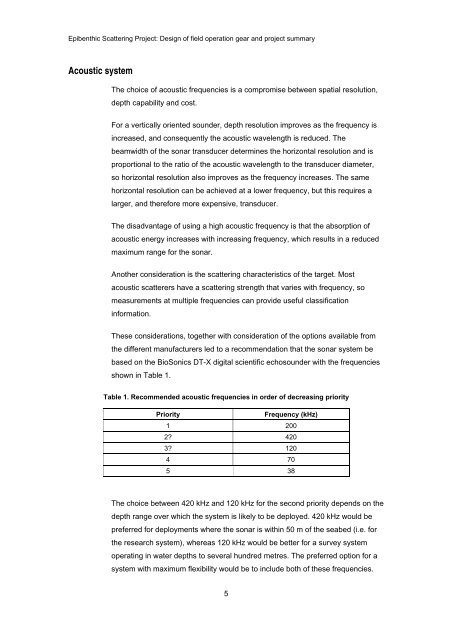Epibenthic scattering project - FTP Directory Listing
Epibenthic scattering project - FTP Directory Listing
Epibenthic scattering project - FTP Directory Listing
Create successful ePaper yourself
Turn your PDF publications into a flip-book with our unique Google optimized e-Paper software.
<strong>Epibenthic</strong> Scattering Project: Design of field operation gear and <strong>project</strong> summary<br />
Acoustic system<br />
The choice of acoustic frequencies is a compromise between spatial resolution,<br />
depth capability and cost.<br />
For a vertically oriented sounder, depth resolution improves as the frequency is<br />
increased, and consequently the acoustic wavelength is reduced. The<br />
beamwidth of the sonar transducer determines the horizontal resolution and is<br />
proportional to the ratio of the acoustic wavelength to the transducer diameter,<br />
so horizontal resolution also improves as the frequency increases. The same<br />
horizontal resolution can be achieved at a lower frequency, but this requires a<br />
larger, and therefore more expensive, transducer.<br />
The disadvantage of using a high acoustic frequency is that the absorption of<br />
acoustic energy increases with increasing frequency, which results in a reduced<br />
maximum range for the sonar.<br />
Another consideration is the <strong>scattering</strong> characteristics of the target. Most<br />
acoustic scatterers have a <strong>scattering</strong> strength that varies with frequency, so<br />
measurements at multiple frequencies can provide useful classification<br />
information.<br />
These considerations, together with consideration of the options available from<br />
the different manufacturers led to a recommendation that the sonar system be<br />
based on the BioSonics DT-X digital scientific echosounder with the frequencies<br />
shown in Table 1.<br />
Table 1. Recommended acoustic frequencies in order of decreasing priority<br />
Priority Frequency (kHz)<br />
1 200<br />
2? 420<br />
3? 120<br />
4 70<br />
5 38<br />
The choice between 420 kHz and 120 kHz for the second priority depends on the<br />
depth range over which the system is likely to be deployed. 420 kHz would be<br />
preferred for deployments where the sonar is within 50 m of the seabed (i.e. for<br />
the research system), whereas 120 kHz would be better for a survey system<br />
operating in water depths to several hundred metres. The preferred option for a<br />
system with maximum flexibility would be to include both of these frequencies.<br />
5


